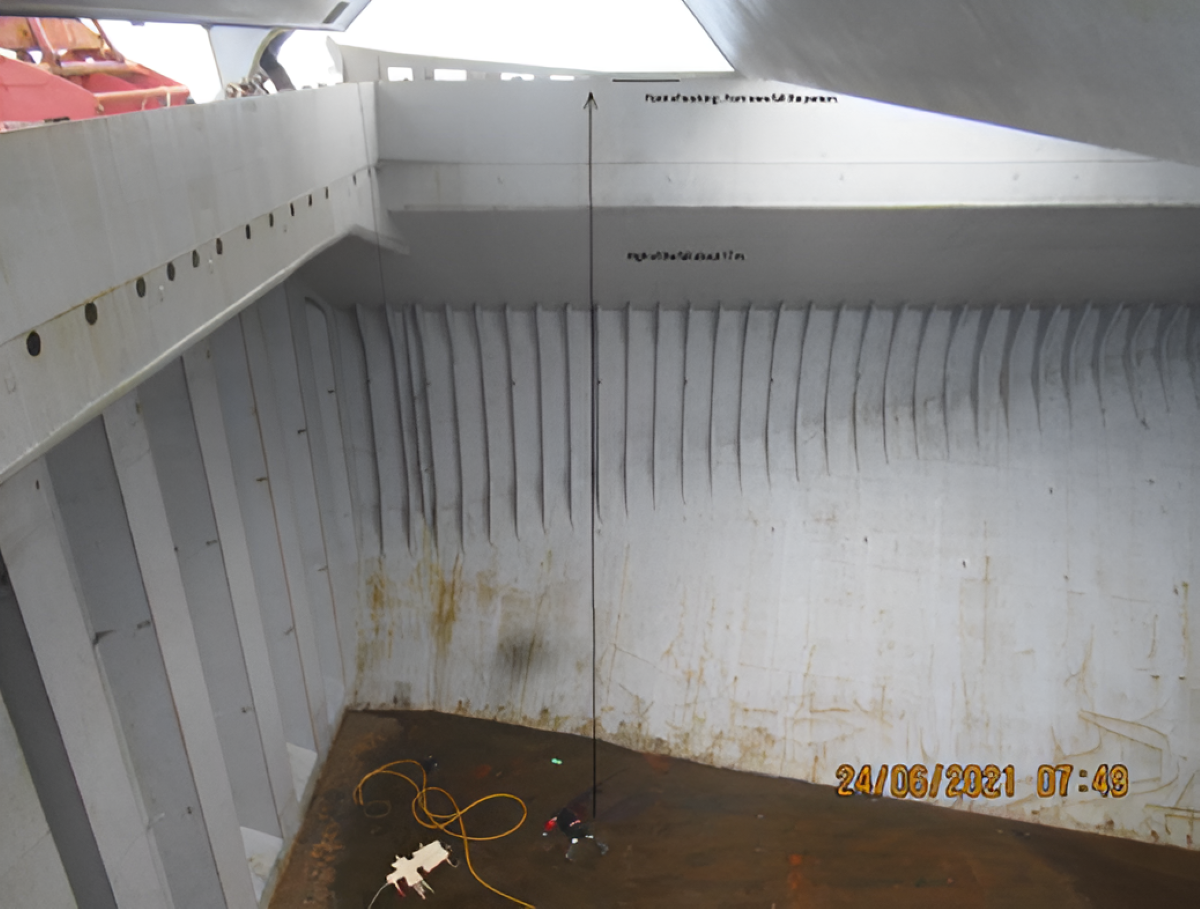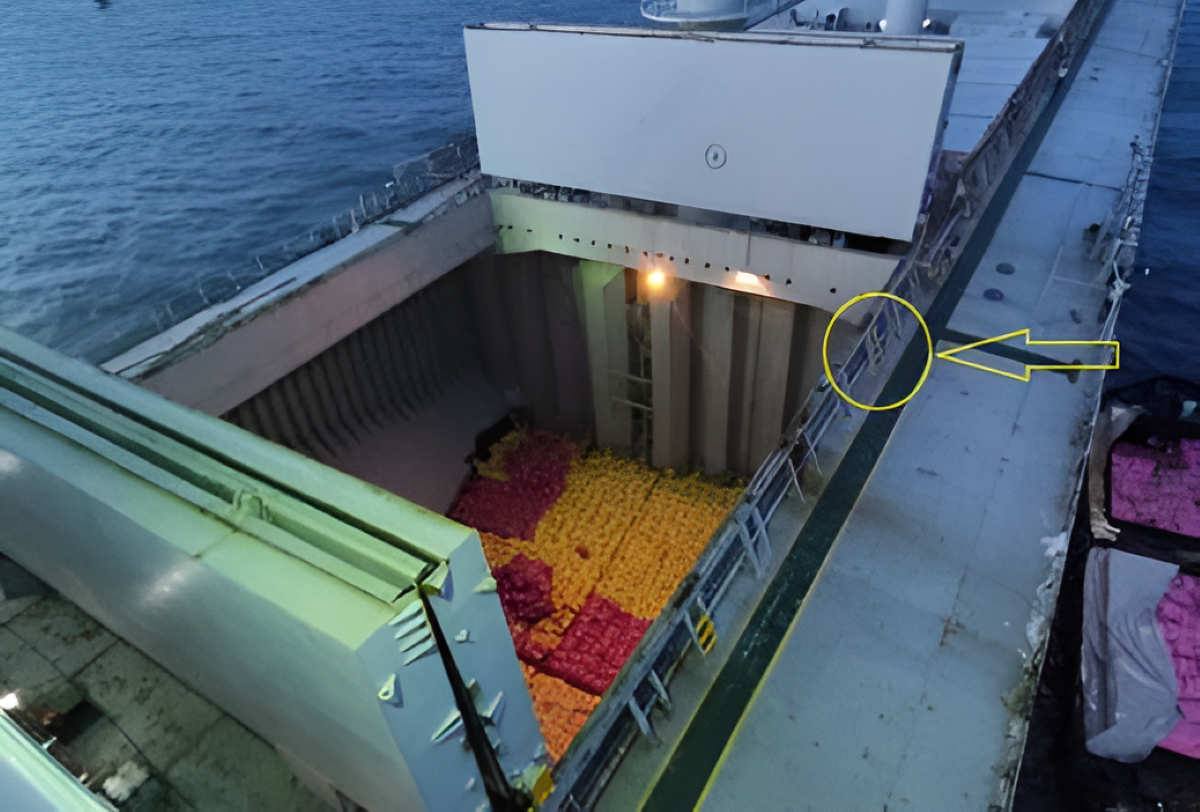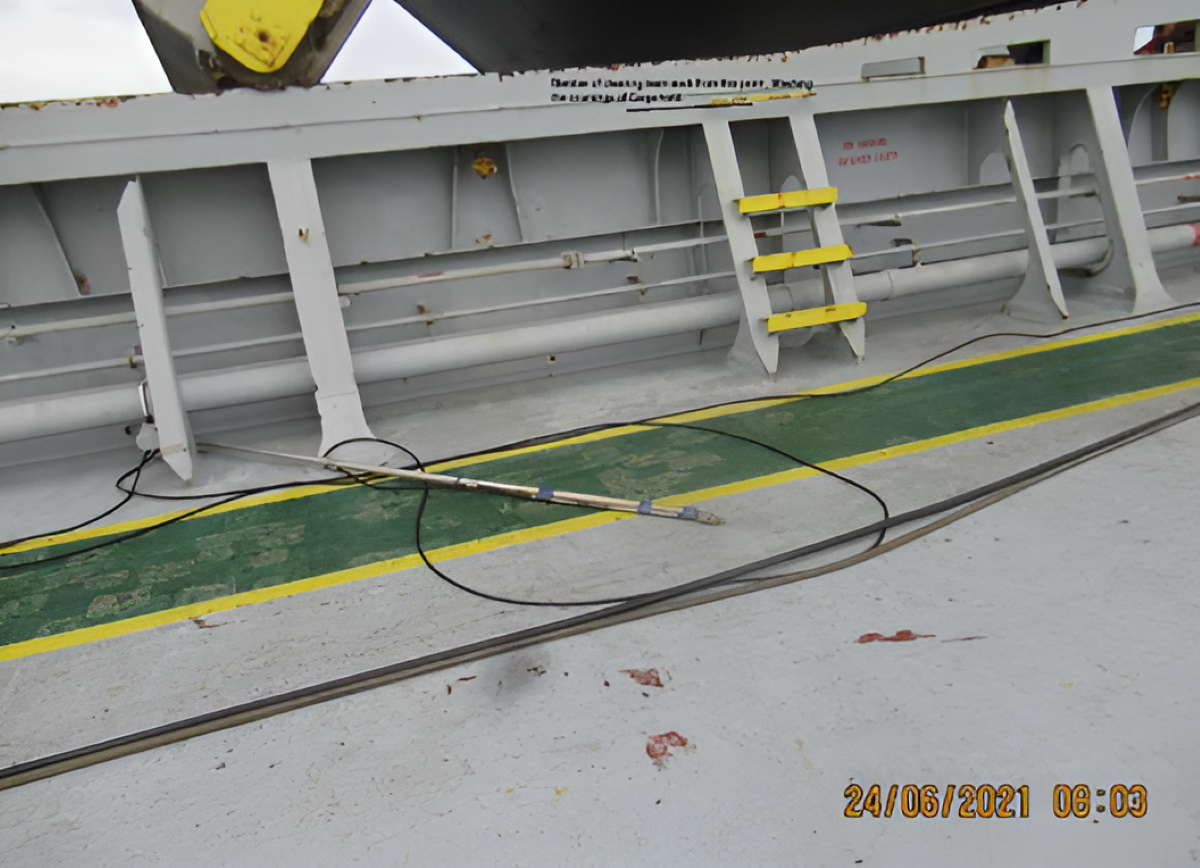A BULK CARRIER WAS TO CARRY OUT CARGO HOLD CLEANING WHILE DRIFTING IN PREPARATION FOR ITS NEXT CARGO WITH THE HELP OF A RIDING TEAM CONTRACTED FROM ASHORE. DURING THE THIRD DAY OF WASHING THE CARGO HOLDS, ONE OF THE RIDING TEAM MEMBERS FELL APPROXIMATELY 17 METRES (FIGURE 1) DOWN INTO CARGO HOLD NO. 5 AND WAS FOUND MOTIONLESS ON THE TANK TOP. THE PERSON WAS LATER PRONOUNCED DEAD.

WHAT HAPPENED
The vessel had discharged its full cargo and thereafter, in the preparation for loading its next cargo, the vessel had to undergo cargo hold cleaning while drifting off port limits. The charterer had contracted a shore riding team of 13 persons, with one being the team leader, to assist in washing down the cargo holds before proceeding to the load port.
Due to Covid-19 restrictions, the riding team and the ship’s crew had to abide by the strict local rules on absolute separation between them without any physical interaction. However, ship’s crew were still to provide equipment and assist in pumping out the bilge water accumulated during the cleaning.
Before starting work, the chief officer had carried out a Tool Box Talk (TBT) with the riding team leader where the safety procedures were discussed. As the riding team members were all experienced in this kind of work, their team leader did not find it necessary to discuss the safety precautions with his team members on daily basis. The team leader also decided that a risk assessment was unnecessary, again this was because the riding team had past experience of cleaning of cargo holds, and he regarded this as a routine task for the team. Nevertheless, the riding team were observed wearing personal protection equipment like safety goggles, helmet and gloves.
The risk assessments completed by the vessel’s chief officer for the hold cleaning, opening and closing of hatch covers and use of high pressure washing apparatus in cargo holds were not provided to the riding team leader for acknowledgment as the chief officer believed these were not applicable to third party contractors.
After the TBT, the riding team commenced cleaning cargo hold no. 5. Meanwhile, the vessel’s crew proceeded to open cargo holds nos. 1 and 2 for inspection and to carry out additional cleaning.
Shortly after, a member of the riding team, who had last been seen standing on the starboard coaming ladder (FIGURE 2) at cargo hold no. 5, fell into the cargo hold from the top of its hatch coaming (FIGURE 3). The water lance he had used for cleaning was later found lying on deck next to where he was last observed standing (FIGURE 4).
The team leader informed the master, and the master then raised the general alarm and informed the deck crew still engaged with work in cargo hold no. 2. The master instructed the chief officer to proceed with the vessel’s medical officer to the incident scene. Meanwhile, the vessel set course towards the nearest port.



LESSONS LEARNED
The following lessons learned have been identified. These are based on the information available in the investigation report and are not intended to apportion blame on any individuals or the company involved.
- There is a gap in the riding team’s familiarisation as they could not speak well in English except for the team leader and this therefore hindered their participation in the tool box talks.
- Risk assessments, when completed by the ship’s crew as per company’s Safety Management System (SMS), should be extended to also include external contractors.
- A risk assessment was assumed unnecessary by the riding team’s leader as he believed that the team members had sufficient prior expertise and experience with cargo hold cleaning. Therefore, the obvious risks of the tasks were not correctly assessed and mitigated. Regardless of prior experience, nobody should tolerate any obvious work-related risks which have not been properly mitigated to as low as practically possible.
- A Permit to Work (PTM) should be completed prior to operation and ensure that all staff are provided with sufficient effective personal protective equipment (PPE) for their assigned job. If the casualty had been wearing proper fall protection, this would likely have prevented the fatality.
- Proper safety barriers, like safety lines, should be rigged across opened hatches.
- The lack of manpower planning, along with the pandemic restrictions and desire to complete multiple tasks simultaneously, probably led to absence of formal supervision of the riding team.
- An effective onboard Stop Work Authority programme could have prevented the incident by enabling any crew members to challenge the unsafe practices and eliminate complacency at work, especially given that the company procedures had reportedly been followed.
For more information on this incident email lossprevention@tindallriley.com
THIS CASE STUDY IS DRAWN FROM THE INVESTIGATION REPORT PUBLISHED BY THE TRANSPORT MALTA – MARINE SAFETY INVESTIGATION UNIT (MSIU).
THE PURPOSE OF THIS CASE STUDY IS TO SUPPORT AND ENCOURAGE REFLECTIVE LEARNING. THE DETAILS OF THE CASE STUDY MAY BE BASED ON, BUT NOT NECESSARILY IDENTICAL TO, FACTS RELATING TO AN ACTUAL INCIDENT. ANY LESSONS LEARNED OR COMMENTS ARE NOT INTENDED TO APPORTION BLAME ON THE INDIVIDUALS OR COMPANY INVOLVED. ANY SUGGESTED PRACTICES MAY NOT NECESSARILY BE THE ONLY WAY OF ADDRESSING THE LESSONS LEARNED, AND SHOULD ALWAYS BE SUBJECT TO THE REQUIREMENTS OF ANY APPLICABLE INTERNATIONAL OR NATIONAL REGULATIONS, AS WELL AS A COMPANY’S OWN PROCEDURES AND POLICIES.

 English
English